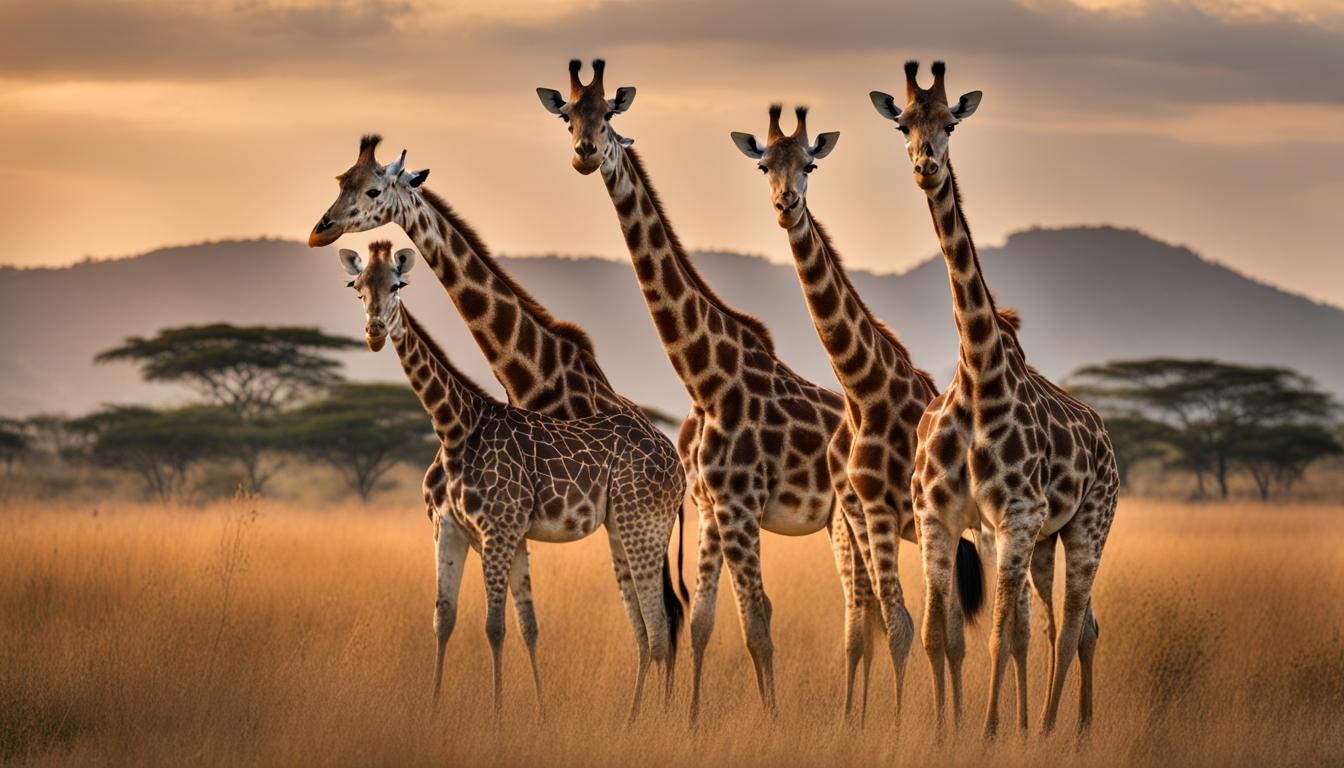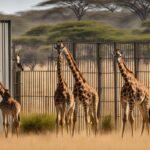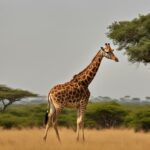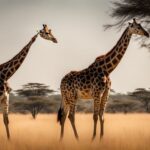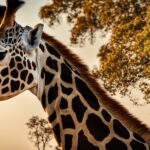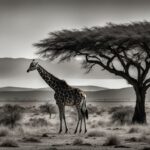Giraffes are iconic creatures that captivate us with their towering height and graceful appearance. However, these majestic animals are currently facing a grave threat to their survival. The conservation status of giraffe populations is a matter of concern, as their numbers have been declining at an alarming rate.
According to the International Union for Conservation of Nature (IUCN), some subspecies of giraffes are now classified as critically endangered. The IUCN recognizes one species and nine subspecies of giraffe, but recent comprehensive DNA analysis has revealed that there are actually four distinct species and several subspecies.
The giraffe population in Africa has plummeted by almost 30% since the 1980s, and in certain areas, numbers have dropped as much as 95%. This decline in population is primarily due to habitat loss, poaching, climate change, and conflicts with humans.
However, there is hope. Conservation efforts are underway to protect giraffes and raise awareness about their declining numbers. Organizations like the Giraffe Conservation Foundation (GCF) are actively involved in research, conservation initiatives, and community partnerships to safeguard giraffe habitats and mitigate key threats.
By working together, we can make a difference in the conservation of giraffes. Stay tuned to learn more about the conservation status of giraffe species and subspecies, the threats they face, and the efforts being made to protect these magnificent creatures.
The Conservation Status of Giraffe Species and Subspecies
The Giraffe Conservation Foundation conducted a comprehensive DNA analysis of giraffe populations throughout Africa, which resulted in an update of the traditional taxonomy. The study revealed that there are four distinct species of giraffe: Masai giraffe, Northern giraffe, Reticulated giraffe, and Southern giraffe. In addition to the species, there are several subspecies within each species. This new taxonomical information will hopefully be considered by the IUCN for future conservation assessments. The genetic analysis has provided valuable insights into the evolutionary relationships among giraffes and highlights the need for species-specific conservation efforts.
| Giraffe Species | Subspecies |
|---|---|
| Masai giraffe | Masai giraffe (G. c. tippelskirchi) |
| Thornicroft’s giraffe (G. c. thornicrofti) | |
| Luangwa giraffe (G. c. luangwaensis) | |
| Northern giraffe | Kordofan giraffe (G. c. antiquorum) |
| Nubian giraffe (G. c. camelopardalis) | |
| Reticulated giraffe | Reticulated giraffe (G. reticulata) |
| Southern giraffe | South African giraffe (G. giraffe) |
| Angolan giraffe (G. angolensis) |
The updated taxonomy of giraffes provides a clearer understanding of the different species and subspecies, allowing for more targeted conservation efforts. Each species and subspecies faces unique challenges and requires specific conservation measures to ensure their survival. The genetic analysis has shed light on the evolutionary history of giraffes and highlights the importance of preserving their diverse genetic heritage.
“The genetic analysis of giraffes has revolutionized our understanding of these magnificent creatures. It is crucial that we consider this new taxonomical information in our conservation efforts and focus on protecting each species and subspecies individually.”
By recognizing the distinct species and subspecies of giraffes and understanding their genetic diversity, conservationists can develop more effective strategies for protecting these iconic animals and their habitats. Public awareness and support are essential in ensuring the long-term survival of giraffes in the wild.
Threats to Giraffe Survival
Giraffes, one of the most iconic species in Africa, are facing numerous threats to their survival. One of the major concerns is habitat loss, as human populations continue to expand and encroach upon giraffe habitats. The natural range of giraffes is shrinking due to deforestation, agricultural expansion, and infrastructure development. These activities result in habitat fragmentation and degradation, making it difficult for giraffes to find suitable food and shelter.
Poaching is another significant threat to giraffes. These majestic creatures are targeted for their meat, skin, and body parts, which are highly sought after in illegal wildlife trade. The demand for giraffe products puts immense pressure on their populations and contributes to their decline. Climate change is also a concern, as it brings about shifts in vegetation patterns and affects the availability of food for giraffes. Disease outbreaks and conflicts with humans further exacerbate the challenges faced by giraffes.
“As human activities continue to encroach upon giraffe habitats, it is crucial that we take immediate action to protect these magnificent animals.”
– Giraffe Conservationist
These threats collectively put the long-term survival of giraffes at risk and highlight the urgent need for conservation action. Efforts to protect giraffe habitats, combat poaching, address climate change impacts, and mitigate conflicts with humans are crucial for ensuring the survival of these remarkable creatures. By raising awareness, supporting conservation organizations, and advocating for stricter wildlife protection laws, individuals can contribute to the preservation of giraffe populations and their habitats.
| Threats to Giraffe Survival | Extent of Impact |
|---|---|
| Habitat Loss | Significant |
| Poaching | High |
| Climate Change | Increasing |
| Disease Outbreaks | Medium |
| Conflicts with Humans | Medium |
It is essential to address these threats on multiple fronts and ensure the long-term survival of giraffes. Conservation programs and initiatives play a vital role in protecting giraffe populations and their habitats. Collaborative efforts between conservation organizations, local communities, and governments are crucial for implementing effective strategies and protecting giraffes for future generations.
Habitat Loss and the Role of Conservation
Habitat loss is the biggest threat to giraffes, but it is also a challenge that can be addressed through conservation efforts. Giraffe conservation programs focus not only on protecting existing habitats but also on creating new ones. Reforestation projects and land management practices help restore and expand giraffe habitats, ensuring that they have sufficient space and resources to thrive.
Conservationists also work closely with local communities to promote sustainable land use practices that benefit both humans and giraffes. By engaging communities in conservation initiatives and providing alternative livelihood options, the pressure on giraffe habitats can be reduced. Additionally, education and awareness programs are crucial in instilling a sense of stewardship and inspiring individuals to take action in protecting giraffes and their habitats.
Efforts to combat poaching involve strengthening law enforcement, raising awareness about the illegal wildlife trade, and supporting anti-poaching units. By addressing the demand for giraffe products and implementing stricter regulations, we can reduce the impact of poaching on giraffe populations and curb the illegal trade.
Conservation Efforts for Giraffes
Protecting giraffes and their natural habitats is a top priority for various organizations and conservation initiatives worldwide. One prominent organization, the Giraffe Conservation Foundation (GCF), is actively involved in giraffe conservation by conducting research, raising awareness, and developing comprehensive conservation programs. Their efforts are focused on protecting giraffe habitats, assessing the current status of giraffe populations, and identifying key threats to their survival.
Collaborative partnerships with local communities play a crucial role in the success of giraffe conservation programs. By involving local people in conservation initiatives, GCF and other organizations ensure that the voices and knowledge of the communities are heard and respected. This approach not only fosters a sense of ownership and pride in protecting giraffes but also helps to address the underlying social and economic factors that contribute to the threats faced by these magnificent creatures.
Advocacy for the inclusion of the updated taxonomical information in future assessments and management plans is another important aspect of giraffe conservation. By recognizing the four distinct species and various subspecies of giraffe, conservation efforts can be tailored to meet the specific needs of each population. This targeted approach allows for a more effective allocation of resources and ensures that conservation measures are tailored to address the unique challenges faced by each giraffe species and subspecies.
To support giraffe conservation initiatives, individuals can contribute by supporting reputable organizations like GCF, participating in responsible tourism, and advocating for stricter wildlife protection laws. By working together, we can help protect these majestic creatures and ensure their survival for future generations.
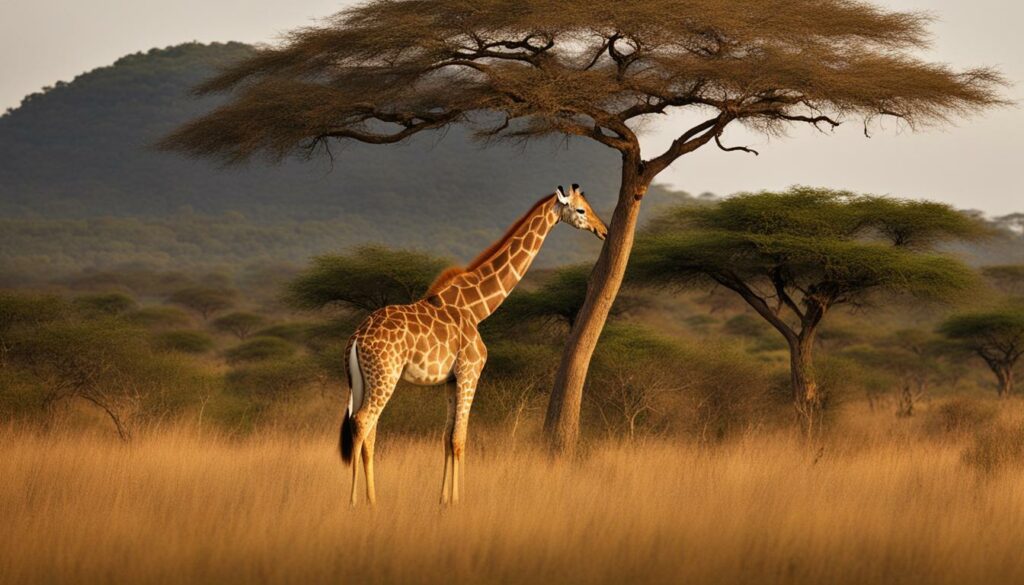
Table: Conservation Programs for Giraffes
| Name of Program | Description | Focus Area |
|---|---|---|
| Giraffe Conservation Foundation (GCF) | Conducts research, raises awareness, and develops conservation initiatives | Protecting giraffe habitats, assessing population status, identifying key threats |
| Local Community Partnerships | Engages local communities in conservation efforts, addressing social and economic factors | Community involvement, social and economic development |
| Advocacy for Updated Taxonomy | Advocates for the inclusion of the updated taxonomical information in assessments and management plans | Tailored conservation measures for each giraffe species and subspecies |
The Current Conservation Status of Giraffe Subspecies
The conservation status of giraffe subspecies varies, with some facing greater threats and higher conservation needs than others. The International Union for Conservation of Nature (IUCN) Red List provides a comprehensive assessment of the conservation status of giraffe subspecies based on population size, trends, and threats they face.
Here is an overview of the current conservation status of giraffe subspecies:
| Subspecies | Conservation Status |
|---|---|
| Angolan Giraffe | Least Concern |
| South African Giraffe | Least Concern |
| Kordofan Giraffe | Critically Endangered |
| Nubian Giraffe | Critically Endangered |
| Reticulated Giraffe | Endangered |
| Thornicroft’s Giraffe | Vulnerable |
| West African Giraffe | Vulnerable |
| Rothschild’s Giraffe | Near Threatened |
It is important to note that each subspecies faces specific threats and requires tailored conservation measures to ensure their survival. The critically endangered Kordofan and Nubian giraffes, for example, have experienced significant population declines due to habitat loss and poaching. Conservation efforts must prioritize these subspecies to prevent their extinction.
By understanding the conservation status of giraffe subspecies and the threats they face, organizations and individuals can better direct their efforts to protect these magnificent creatures and ensure their long-term survival.
Conclusion
Giraffe conservation is of utmost importance as these majestic creatures face significant threats to their populations. It is crucial to raise awareness about their declining numbers and take action to protect them and their habitats.
Efforts should be focused on preserving giraffe habitats, conducting research to understand their populations and behaviors, and identifying and addressing key threats. Collaboration with local communities plays a vital role in successful conservation initiatives.
As an individual, you can make a difference in giraffe conservation. Support reputable giraffe conservation organizations through donations or volunteering. Additionally, consider participating in responsible tourism practices that prioritize wildlife welfare and conservation. By advocating for stricter wildlife protection laws, you can help create a safer environment for giraffes and other endangered species.
Together, we can ensure the survival and long-term conservation of giraffes for future generations to admire and cherish. Protecting these incredible animals is not only essential for their well-being but also for maintaining the ecological balance of our planet.
Have any famous individual giraffes played a role in wildlife conservation efforts?
Famous giraffes in wildlife conservation have indeed played a notable role in preserving endangered species. These individuals, with their prominence and influence, have raised awareness, funding, and support for various conservation initiatives globally. Their involvement has been instrumental in safeguarding the habitats and populations of various wildlife species, contributing to the overall conservation efforts.
FAQ
What is the current conservation status of giraffe populations?
Giraffe populations are facing a real threat, with some subspecies being classified as critically endangered. The giraffe population in Africa has dropped by almost 30% since the 1980s, and in some areas, numbers have decreased by as much as 95%. Conservation efforts are underway to protect these majestic creatures and raise awareness of their declining numbers.
What are the different species and subspecies of giraffes?
Based on recent comprehensive DNA analysis, there are four distinct species of giraffe: Masai giraffe, Northern giraffe, Reticulated giraffe, and Southern giraffe. Each species has several subspecies. This new taxonomical information will hopefully be considered by the IUCN for future conservation assessments.
What are the main threats to giraffe survival?
Giraffes face numerous threats, with habitat loss being a major concern. Deforestation, agricultural expansion, and infrastructure development are all contributing to habitat fragmentation and degradation. Poaching, climate change, disease outbreaks, and conflicts with humans further exacerbate the challenges faced by giraffes.
What conservation efforts are in place for giraffes?
Various organizations and initiatives are working to protect giraffes and their habitats. The Giraffe Conservation Foundation is actively involved in giraffe conservation, conducting research, raising awareness, and developing initiatives. Efforts are focused on protecting giraffe habitats, establishing population status, and identifying key threats. Collaborative partnerships with local communities are crucial for successful conservation programs.
What is the conservation status of giraffe subspecies?
According to the IUCN Red List, giraffe subspecies have varying conservation statuses. The Angolan giraffe and South African giraffe are classified as least concern. The Kordofan giraffe and Nubian giraffe are critically endangered, while the Reticulated giraffe is endangered. Thornicroft’s giraffe is vulnerable, and the West African giraffe and Rothschild’s giraffe are classified as near threatened and vulnerable, respectively.
How can individuals contribute to giraffe conservation?
Individuals can support reputable giraffe conservation organizations, participate in responsible tourism, and advocate for stricter wildlife protection laws. By working together, we can help protect these majestic creatures and ensure their survival for future generations.

